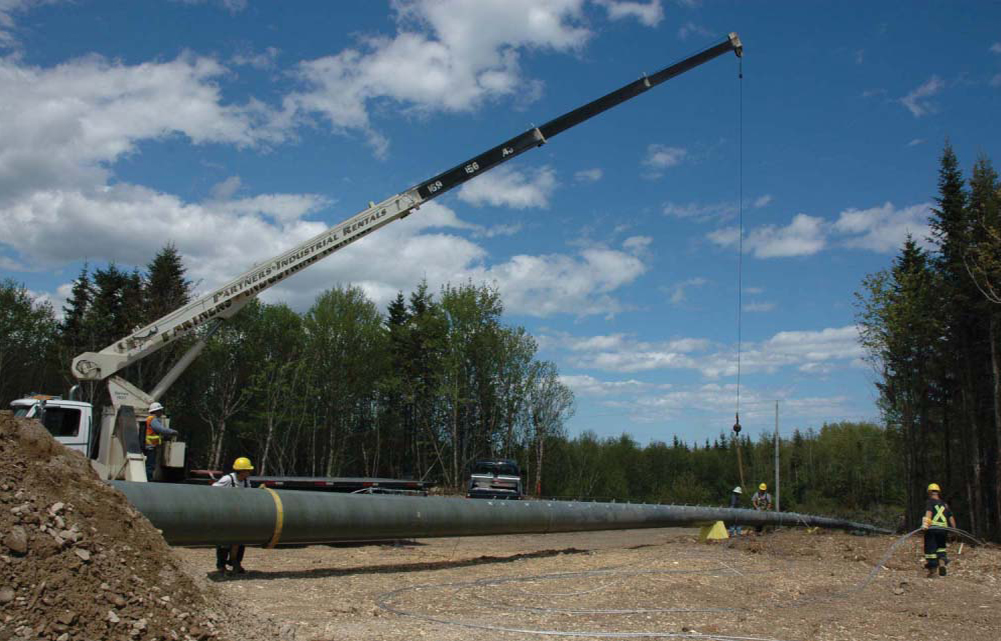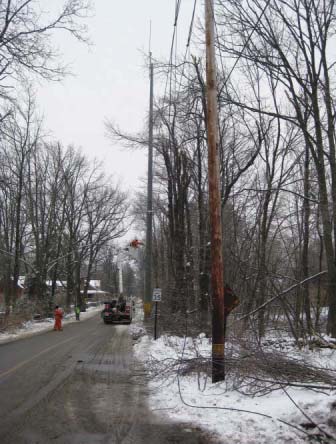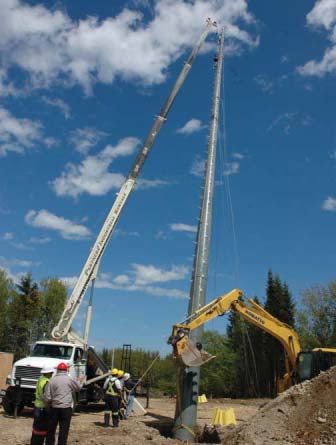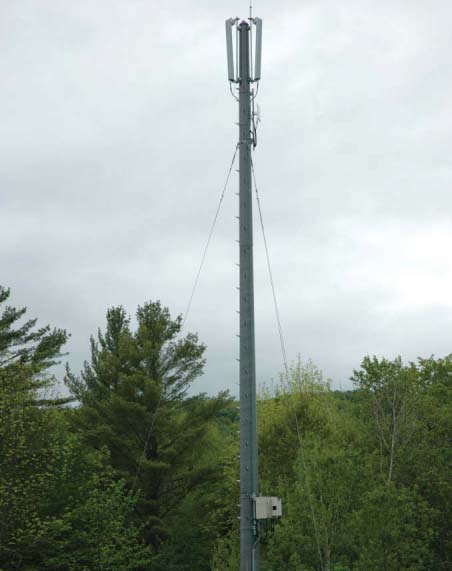A modular composite monopole combines structural rigidity, strength and height capability, tower characteristics needed by the broadband and Wi-Fi industries. Composite poles are relatively maintenance-free and environmentally benign.
By Kevin C. Coates

Access to widespread, reliable, and affordable broadband Internet service for rural customers is a technical and financial challenge. The cost of providing extensive coverage is always weighed against the ability of service providers to recover their deployment costs through competitive (i.e., affordable) user fees. With governments covering much of the initial infrastructure capital costs, the economics can work so that rural communities have a viable option to purchase high-speed Internet access.
Finding ways to lower deployment and maintenance costs only improves the economics. The structure upon which a piece of broadband equipment sits can represent a considerable portion of a system’s network investment. And, once they are in place, these structures need to withstand the daily onslaught of weathering with minimal need for maintenance over time. In other words, the more sustainable and resilient a structure, the more it proves to be cost effective.
With the introduction of high-strength, maintenance-free composite poles, broadband providers now have an extremely cost-effective platform upon which to site their equipment. Not only do composite materials drastically reduce the frequency of pole inspections and the need for pole maintenance, but also composite poles are often the lowest-cost and fastest structures to erect for Wi-Fi providers. Those companies that have already chosen to deploy them see these new composite poles as game changers to their bottom lines.
From R&D to the field
Because of the confluence of advances in material science, some innovative manufacturing methods and some timely marketing, composite poles are now the latest option in the toolbox for delivering cost-effective wireless Internet service. However, not all composite poles are designed or manufactured the same nor are they all well suited for use in broadband infrastructure.
Otherwise known as fiber-reinforced polymers (FRPs), composite pole technology was originally conceived and designed to support electric power transmission and distribution lines. Although they are lightweight, FRPs are stronger than steel. Their strength is derived from combining E-glass fibers with various combinations of thermoset resins. Several manufacturers provide electric utilities with composite poles, and each company tightly guards its own proprietary composite formula along with its manufacturing methods.
All composite poles are stronger than steel and do not corrode, and their light weight makes them faster and easier to erect. They are fire resistant and impervious to insects. They do not conduct electricity. These new poles have a rated service life of 80 years, and they are also maintenance free. Of particular interest to the broadband community, composite poles do not interfere with transmission signals.
One FRP product, made by RS Technologies Inc. of Calgary, Alberta, Canada, is particularly well suited for the broadband arena. Its design allows network operators to easily configure customized poles from standard modules based on the unique conditions of the installation site. Because these monopoles are composed of tapered sections, complete monopoles are shipped with the modules nested one inside another and assembled at a staging area. Because the length of the modules is always less than 37 feet (11.3 meters), they require no transport permits and, as a result, are faster, easier, and less costly to ship. The larger-diameter modules are especially well suited for the tight deflection tolerances required for broadband’s targeted line-of-sight microwave backhaul. If it’s necessary to increase the height of a pole to accommodate new equipment for extending the signal further than originally specified, additional modules can be added to increase overall pole height. RS poles can reach above-ground heights of up to 135 feet (41 meters).
Throughout the world, utilities and broadband providers are now beginning to deploy these new poles with greater frequency and with excellent results. The stories of three broadband providers in North America are indicative of the difference composite modular monopoles can make to a system.
Strength and durability
In December 2008, a brutal storm slammed the northeastern part of North America and blanketed the area with a layer of ice up to 1-1/2 inches thick. Wooden utility poles snapped like toothpicks after heavily laden trees fell onto power lines and poles, and weeks went by before the power grid was completely restored. The most time-consuming, dangerous, miserable and expensive part of grid reconstruction was setting new power poles in frozen soil. This can also apply to any broadband structure that might go down in a winter storm.

After the storm, only one wireless broadband transceiver was left in operation in Princeton, Mass., and it sat atop one of 24 dual-use RS monopoles that were all undamaged. Princeton Municipal Light Department General Manager Jonathan Fitch explained that the utility uses 75- to 80-foot monopoles so they can support power lines on crossarms at lower levels and reserve the upper reaches of the poles for broadband equipment. He said that in the aftermath of the storm, 150 wood poles were destroyed (out of a total of about 2,900 poles) and one-third of the wires in his utility’s 34-square-mile grid were on the ground. The strength and resilience of composites for supporting sensitive electronics and electric power lines in severe weather conditions were instantly obvious to Fitch.
Getting Wi-Fi to the people
Two North American rural broadband initiatives worked fast to implement Internet access in the summer of 2009 using RS monopoles as their support structures, one in Vermont and New Hampshire and the other in Nova Scotia.

The nonprofit Northern Community Investment Corporation (NCIC) spearheaded the Vermont/New Hampshire project to bring wireless broadband into three northern counties in Vermont and three northern counties in New Hampshire, an area comprising 6,000 square miles. Sen. Judd Gregg (R-N.H.) has been instrumental in securing more than $2 million in federal funds to help fund this project designed to uplift these economically depressed counties in upper New England. The federal funds helped shore up project support from local banks that found themselves lending in a fragile local economy.
NCIC Project Director Tom Joyce pointed out that this broadband initiative was seen as a major economic development tool for the upper reaches of rural Vermont and New Hampshire. When the projects were completed, 240,000 people living in and around 130 communities received access to high-speed Internet service.
RS monopoles gave NCIC more bang for the buck and greater flexibility in how it deployed the poles. Joyce pointed out that “RS monopoles eliminated the need for concrete foundations because the composite poles could be ‘direct buried.’ When a foundation does not have to be poured, it typically saves NCIC up to $20,000 for each site.”

Joyce also explained that siting a pole on a mountaintop, an obviously desirable location, frequently poses serious logistical problems for construction crews: Roads need to be cut and graded through forests, construction equipment and materials need to be transported up to the site, and crews have to commute back and forth until the project is complete. Because a composite pole can be installed in hours rather than days and without the need for several days of concrete truck convoys, serious savings can be realized. In addition, smaller, less-expensive cranes and smaller crews can be used to install the composite poles.
With 24 RS monopoles installed by the end of 2009 by NCIC, the investment corporation’s savings just for the installations became obvious. Maintenance costs for these poles are basically limited to periodic inspections.
Both the poles and their installation process are relatively unobtrusive. In Dalton, N.H., population 1,000, Police Chief John Tholl said the new composite pole tower across the street from the police station supports his town’s new high-speed Internet access. Chief Tholl bought a dozen old computers and new hard drives for 50 bucks so he could set up an Internet café in the town’s main office building, just so Dalton residents without computers could have Internet access.
Provincewide broadband
Farther to the northeast, the Broadband for Rural Nova Scotia initiative was implemented to deliver high-speed Internet access to 100 percent of Nova Scotians. With the initiative complete at the end of 2009, the entire province received high-speed Internet access, making Nova Scotia one of the most connected jurisdictions in North America. The Nova Scotia project covers an area roughly equal to the size of West Virginia, with Seaside’s contract area slightly larger than the state of New Jersey.
Seaside Wireless Communications, one of three providers for the Nova Scotia broadband initiative, is so far using 97 RS monopoles in its system. Overseeing the project is Seaside Wireless Regional Manager Mac Fuller. His confidence in the composite pole was clear when he said, “Our early construction efforts confirmed the many advantages of using the RS monopole. At the time, this was a relatively new application of the product, but RS worked with us to quickly develop the specific telecom and safety hardware we required. The logistics advantages of the RS allowed us to keep ahead of a very tight build schedule. The modular concept also allows us tremendous inventory flexibility with our installations ranging from 65 to 135 feet (20 to 41 meters) in above ground height, all constructed from standard modules.
“We are continuing to find new applications for this versatile product, and the RS engineering team has always been there to support us. In the end, the RS modular concept allowed for quick lead times, fast, economical, and permit-free transportation from our central yard to the sites and very efficient pole assembly and setting,” Fuller said.
Jeff St. Aubin, the project manager with Morrison Hershfield, the project’s design engineering firm, said, “After our analysis was complete, the RS was the obvious monopole choice for this broadband project. The standard-sized nesting modules allowed for quick lead time and cost-effective transportation. Pole assembly and setting are very efficient with this system, which allowed us to expedite our build schedule. We also have the flexibility to deploy larger base modules today and add new top modules in the future to increase the pole height to accommodate future network upgrades or site-sharing revenue opportunities. The RS pole is the only monopole system that offers this many solutions and is maintenance free.”

During a June 2009 installation near Terra Nova on Cape Breton, a Seaside installation crew erected a 93-foot RS monopole in just over an hour. MacKenzie Brothers Construction out of West Bay, N.S., provided a Komatsu excavator that cleared the trees, created a short access road, and dug the pole’s hole in just two days (the standard embedment depth is 10 percent of the pole height, plus 2 feet). Once the medium-size crane arrived from Partner Crane Rentals in Pictou, N.S., the entire operation, including tensioning of the guys, took a little over an hour, in spite of this installation being the crane operator’s first with a monopole.
Fred Bird, a construction supervisor for Seaside, said that with each installation his crews were quickly learning new and faster methods of installing the composite poles and that they were looking forward to future RS monopole installations.
Robust, maintenance-free platforms
The FRP production process varies among pole manufacturers and is proprietary; some poles are manufactured using a pultrusion method, while others, such as RS, spin E-glass fibers around a mandrel. As previously mentioned, RS Technologies’ composite poles are 75 percent E-glass and 25 percent thermoset resins, with the outermost layers using special resins that shield the inner-strength resin layers from UV damage. The material and physical advantages of the different types of composite poles vary among manufacturers.
What is of particular interest to all potential users of composite poles is that they share the common characteristic of being relatively maintenance-free and environmentally benign. Even in environments where there is danger of fire, fireproof coatings can be applied to reduce the risk of damage from fire.
However, for use as a broadband or Wi-Fi platform, so far only the modular RS composite monopole has the necessary combination of structural rigidity, strength and height capability needed by these industries.
Kevin C. Coates is president of Coates Consult, Bethesda, Md. His email address is kevin.coates@verizon.net.